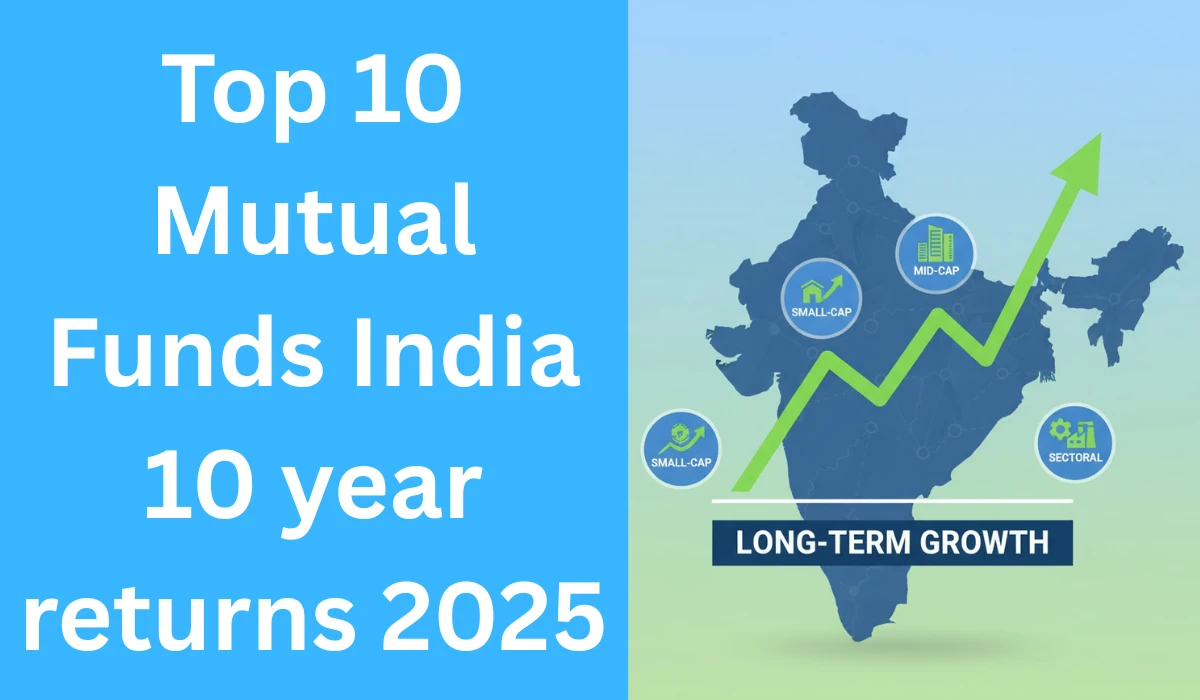Mutual Funds in India: A Decade of Growth
Mutual funds have transformed India's investment ecosystem over the past decade. From 2015 to 2025, the industry expanded dramatically, with assets under management (AUM) surging from around ₹9 lakh crore to over ₹65 lakh crore by March 2025, according to the Association of Mutual Funds in India (AMFI). This growth reflects rising financial literacy, digital platforms, and favorable regulations like the Systematic Investment Plan (SIP) push.
Equity funds, particularly those targeting small- and mid-cap segments, drove much of this momentum. The Nifty Smallcap 250 Index returned over 300% cumulatively during this period, outpacing the Nifty 50's 180% gains. However, this came amid cycles of boom and bust, including the 2020 COVID crash and 2022 inflation pressures.
For investors, these funds offer professional management and diversification. Yet, as SEBI emphasizes, past performance isn't indicative of future results. The top performers analyzed here—spanning ELSS, small-cap, and sectoral categories—demonstrate resilience but underscore the need for a 7-10 year horizon.
Transitioning to selection criteria, understanding the filtering process ensures transparency in identifying these standouts.
How These Top Mutual Funds Were Selected
The selection process focused on equity-oriented schemes, including diversified, thematic, and sectoral funds, excluding debt or hybrid variants. Data spanned October 2015 to October 2025, prioritizing absolute 10-year returns for a clear wealth-creation metric.
Key filters included:
-
Minimum 10-year track record to capture multiple market cycles.
-
10-year CAGR between 19.5% and 22%, equating to 495%-630% absolute growth.
-
Exclusion of funds with excessive churn or regulatory flags.
Sources like Value Research and Moneycontrol provided verified NAV histories. This yielded a ranked list emphasizing long-term compounding over short-term spikes. Notably, small- and mid-cap dominance reflects India's structural shift toward consumption and infrastructure.
Now, a snapshot of the rankings sets the stage for deeper dives.
Top 10 Mutual Funds: Performance Snapshot
The following table outlines the leading funds, their 10-year metrics, and growth illustration for a ₹1 lakh investment.
| Rank | Mutual Fund Scheme | 10-Year CAGR (%) | 10-Year Absolute Returns (%) | ₹1 Lakh Grew To (approx.) |
|---|---|---|---|---|
| 1 | Quant ELSS Tax Saver Fund | 22.0 | 631 | ₹7.31 Lakh |
| 2 | Nippon India Small Cap Fund | 21.8 | 616 | ₹7.16 Lakh |
| 3 | Quant Small Cap Fund | 20.3 | 538 | ₹6.38 Lakh |
| 4 | Quant Infrastructure Fund | 20.1 | 528 | ₹6.28 Lakh |
| 5 | Invesco India Mid Cap Fund | 20.1 | 528 | ₹6.28 Lakh |
| 6 | DSP Natural Resources and New Energy Fund | 19.9 | 518 | ₹6.18 Lakh |
| 7 | Quant Flexi Cap Fund | 19.9 | 518 | ₹6.18 Lakh |
| 8 | Axis Small Cap Fund | 19.8 | 513 | ₹6.13 Lakh |
| 9 | HDFC Small Cap Fund | 19.8 | 513 | ₹6.13 Lakh |
| 10 | Kotak Midcap Fund | 19.5 | 495 | ₹5.95 Lakh |
Data as of October 12, 2025. These figures highlight small-cap tilt, with six of ten funds in that category.
Delving deeper, each fund's objective, highlights, suitability, and risks reveal nuances.
Deep Dive: #1 Quant ELSS Tax Saver Fund
Fund Overview and Strategy
Launched in 1996, Quant ELSS Tax Saver Fund blends tax efficiency with growth. It invests primarily in diversified equities, mandating a three-year lock-in under Section 80C for deductions up to ₹1.5 lakh annually. Managed by Sanjeev Sharma and Shamil Mehra, the fund employs a momentum-based approach, tilting toward high-conviction picks across caps.
As of October 2025, AUM stands at ₹11,396 crore, with 99% in equities: 54% large-cap, 10% mid-cap, and 6% small-cap. Top sectors include financials (25%) and IT (15%), per Value Research.
Performance Breakdown
- 3-Year CAGR: 16.5%
- 5-Year CAGR: 27.9%
- 10-Year CAGR: 22.0%
- Absolute 10Y Return: 631%
A ₹1 lakh investment in 2015 would exceed ₹7.3 lakh today, outperforming the Nifty 500 by 4% annually. Recent NAV: ₹415.35.
Who Should Consider This Fund?
Ideal for tax-conscious investors with moderate-high risk tolerance and 5+ year horizons. It suits salaried professionals seeking dual benefits of savings and growth.
Key Risks and Mitigation
High volatility from mid/small-cap exposure (beta: 1.2) amplifies downturns, as seen in 2022's 15% dip. Economic slowdowns hit aggressive picks hard. Diversify with large-cap funds; monitor quarterly reallocations.
Quant's quant-driven model minimizes biases but relies on data accuracy.
Deep Dive: #2 Nippon India Small Cap Fund
Fund Overview and Strategy
Established in 1995, this fund targets small-cap firms with scalable models and earnings momentum. Managed by Samir Rachh and Dhrumil Shah, it maintains a broad 235-stock portfolio for risk spread. AUM: ₹64,422 crore as of October 2025.
Allocation: 95% equities, with 44% small-cap, 12% mid-cap, and 8% large-cap. Sectors like industrials (20%) and healthcare (15%) dominate, emphasizing undervalued growth stories.
Performance Breakdown
- 3-Year CAGR: 23.3%
- 5-Year CAGR: 33.5%
- 10-Year CAGR: 21.8%
- Absolute 10Y Return: 616%
NAV: ₹189.42. It beat the Nifty Smallcap 250 by 3% annually, turning ₹1 lakh into ₹7.16 lakh.
Who Should Consider This Fund?
Long-term investors tolerant of volatility, eyeing alpha from small-cap rallies. Suits those with 7+ year views on India's consumption boom.
Key Risks and Mitigation
Short-term swings (standard deviation: 18%) and liquidity crunches in bear phases pose threats. 2020 saw a 40% drawdown. Limit to 10-15% portfolio; pair with debt for ballast.
Low turnover (13%) aids tax efficiency but may lag in rotations.
Deep Dive: #3 Quant Small Cap Fund
Fund Overview and Strategy
Since 2013, this fund chases high-potential small-caps via quantitative screens. Managed by Pushpa Rai, it holds 93% equities: 33% small-cap, 18% mid-cap, 13% large-cap. AUM: ₹29,288 crore.
Focus: Multi-sector, with energy (20%) leading. Strategy leverages algorithms for entry/exit timing.
Performance Breakdown
- 3-Year CAGR: 25.2%
- 5-Year CAGR: 35.2%
- 10-Year CAGR: 20.3%
- Absolute 10Y Return: 538%
NAV: ₹280.46. Outperformed peers by 2%, growing ₹1 lakh to ₹6.38 lakh.
Who Should Consider This Fund?
Aggressive growth seekers comfortable with 20%+ volatility. Best for 10-year horizons.
Key Risks and Mitigation
Valuation bubbles and slowdowns amplify losses (Sortino ratio: 0.5). 2022 correction: -25%. Cap allocation at 10%; use SIPs to average costs.
Deep Dive: #4 Quant Infrastructure Fund
Fund Overview and Strategy
Targeting infra themes since 1996, managed by Sanjeev Sharma. 94% equities in construction, energy (AUM: ₹3,223 crore). Portfolio: 63% large-cap, 31% small-cap.
Performance Breakdown
- 3-Year CAGR: 20.5%
- 5-Year CAGR: 34.3%
- 10-Year CAGR: 20.1%
- Absolute 10Y Return: 528%
₹1 lakh to ₹6.28 lakh; NAV: ₹42.08.
Who Should Consider This Fund?
Infra-bullish investors with sectoral focus. 7+ years ideal.
Key Risks and Mitigation
Policy delays (beta: 1.1); 2019 slowdown hit 30%. Diversify sectors.
Deep Dive: #5 Invesco India Mid Cap Fund
Fund Overview and Strategy
Launched 2006, managed by Amit Ganatra and Aditya Khemani. Focus: Quality mid-caps with strong balance sheets. AUM: ₹8,531 crore; 99% equities (31% mid, 19% small).
Performance Breakdown
- 3-Year CAGR: 29.1%
- 5-Year CAGR: 29.6%
- 10-Year CAGR: 20.1%
- Absolute 10Y Return: 528%
NAV: ₹220.52; ₹1 lakh to ₹6.28 lakh.
Who Should Consider This Fund?
Medium-term growth hunters. 5-7 years.
Key Risks and Mitigation
Mid-cap corrections (std dev: 16%); liquidity issues. Balance with large-caps.
Deep Dive: #6 DSP Natural Resources and New Energy Fund
Fund Overview and Strategy
Since 1996, invests in resources and renewables. Managed by Rohit Singhania; AUM: ₹1,391 crore. 86% equities: 50% large, 21% mid; energy/metals heavy.
Performance Breakdown
- 3-Year CAGR: 24.0%
- 5-Year CAGR: 28.8%
- 10-Year CAGR: 19.9%
- Absolute 10Y Return: 518%
NAV: ₹105.07; ₹1 lakh to ₹6.18 lakh.
Who Should Consider This Fund?
Commodity/energy theme believers. High risk tolerance.
Key Risks and Mitigation
Price volatility (Sharpe: -0.07); global macros. Limit to 5-10%.
Deep Dive: #7 Quant Flexi Cap Fund
Fund Overview and Strategy
Dynamic all-cap since 2008; managed by Sanjeev Sharma. AUM: ₹6,687 crore; 86% equities (45% large, 16% mid).
Performance Breakdown
- 3-Year CAGR: 18.3%
- 5-Year CAGR: 27.2%
- 10-Year CAGR: 19.9%
- Absolute 10Y Return: 518%
NAV: ₹106.92; ₹1 lakh to ₹6.18 lakh.
Who Should Consider This Fund?
Diversified exposure seekers. Flexible horizons.
Key Risks and Mitigation
Churn risks (turnover: 50%); market beta 1.0. Monitor reallocations.
Deep Dive: #8 Axis Small Cap Fund
Fund Overview and Strategy
Quality small-caps since 2013; managed by Ashish Naik. AUM: ₹23,500 crore (est.); 89% equities (42% small).
Performance Breakdown
- 3-Year CAGR: 19.9%
- 5-Year CAGR: 27.5%
- 10-Year CAGR: 19.8%
- Absolute 10Y Return: 513%
NAV: ₹121.13; ₹1 lakh to ₹6.13 lakh.
Who Should Consider This Fund?
Long-term alpha chasers. 7+ years.
Key Risks and Mitigation
Volatility (std dev: 16%); liquidity. SIP focus.
Deep Dive: #9 HDFC Small Cap Fund
Fund Overview and Strategy
Growth-oriented small-caps since 1999; managed by Chirag Setalvad. AUM: ₹30,000 crore+; high-conviction picks.
Performance Breakdown
- 3-Year CAGR: 23.7%
- 5-Year CAGR: 31.1%
- 10-Year CAGR: 19.8%
- Absolute 10Y Return: 513%
NAV: ₹161.58; ₹1 lakh to ₹6.13 lakh.
Who Should Consider This Fund?
Wealth creators with 7-10 years.
Key Risks and Mitigation
Corrections impact valuations. Diversify.
Deep Dive: #10 Kotak Midcap Fund
Fund Overview and Strategy
Quality mid-caps since 1994; managed by Pankaj Tibrewal. AUM: ₹58,300 crore; consistent earnings focus.
Performance Breakdown
- 3-Year CAGR: 23.8%
- 5-Year CAGR: 29.0%
- 10-Year CAGR: 19.5%
- Absolute 10Y Return: 495%
NAV: ₹161.52; ₹1 lakh to ₹5.95 lakh.
Who Should Consider This Fund?
Balanced risk-return profiles. Medium-long term.
Key Risks and Mitigation
Sector concentrations; corrections. Peer comparison shows outperformance.
Small and Mid-Cap Funds: Balancing High Rewards with Volatility
Small- and mid-cap funds dominated this list, reflecting their edge in growth phases. Benefits include superior returns—small-caps averaged 18% CAGR vs. large-caps' 12% from 2015-2025—and diversification into emerging sectors like renewables.
India's mid/small-cap indices grew 250-300%, fueled by domestic consumption and reforms. Yet, risks loom: higher beta (1.2-1.5) means 30-50% drawdowns in bears, liquidity traps, and sensitivity to rates.
| Aspect | Small-Cap Funds | Mid-Cap Funds |
|---|---|---|
| Growth Potential | High (20%+ CAGR possible) | Moderate-High (15-20% CAGR) |
| Volatility | Very High (std dev 20%+) | High (std dev 15-18%) |
| Liquidity Risk | Elevated | Moderate |
| Ideal Horizon | 7-10 years | 5-7 years |
Mitigate via SIPs and 10-20% allocation.
Sectoral Funds: Thematic Opportunities and Pitfalls
Funds like Quant Infrastructure and DSP Natural Resources tap mega-trends. India's infra spend hit ₹11 lakh crore in FY25, boosting returns. Benefits: Alpha from policy tailwinds.
Risks: Concentration—commodity slumps erased 20% in 2023. Limit to 5-10%; rotate with cycles.
ELSS and Flexi-Cap: Tax and Flexibility Edges
ELSS like Quant offers 80C perks alongside equity upside. Flexi-caps adapt allocations, reducing timing errors.
Both suit diversified portfolios but inherit equity volatility.
The Indian Mutual Fund Landscape: Trends Shaping 2025
From 2015-2025, SIPs exploded to ₹26,632 crore monthly inflows by April 2025, per AMFI. Equity AUM share hit 37%, with small/mid-caps at 20%. Digital adoption—33% via apps—drove 32% folio growth to 23.45 crore.
Challenges: Penetration at 19.9% GDP lags peers. Regulatory tweaks, like 2024's expense caps, enhance trust.
Risk Management Strategies for Long-Term Success
Diversify across caps (40% large, 30% mid, 20% small, 10% debt). Use SIPs for rupee-cost averaging. Rebalance annually; stress-test via tools like Value Research.
Tax: LTCG over ₹1.25 lakh at 12.5% post-1 year.
Conclusion: Building Wealth Through Informed Choices
The past decade rewarded disciplined equity exposure, with these funds exemplifying compounding's might. Yet, amid 2025's uncertainties—geopolitics, rates—focus on goals over recency. Consult advisors; start small via SIPs. As AMFI notes, sustained participation unlocks India's growth story.
👉 To see amazing offers from 'Smart Deals' for shopping Click here













